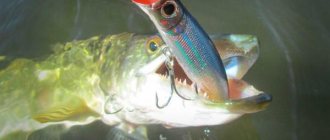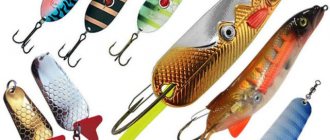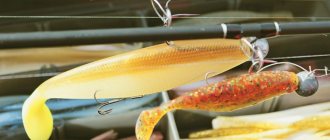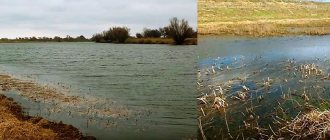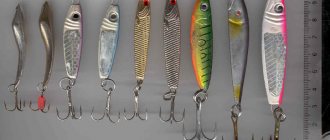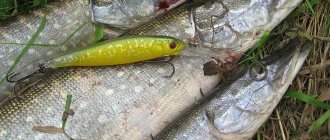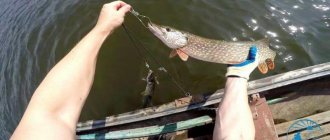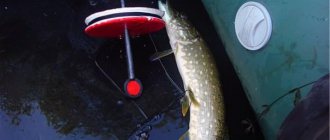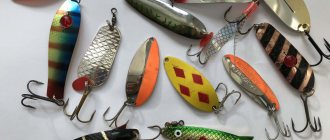The range of baits used when catching predatory fish is so wide that it sometimes surprises you with its diversity. Some of them imitate a sick, wounded fish, others repeat the movement of possible prey, and others copy its appearance. Among these baits, poppers for pike stand out, in certain conditions outperforming the more familiar wobblers, spinners and silicone.
Fishing Features
First, let's get acquainted with the bait. It is made in the shape of a fish with an open mouth, its appearance is shown in the photo above. If a wobbler, thanks to the blade protruding from the front, is capable of going deep, then this is impossible for such a bait. It moves along the surface of the water and makes squelching sounds, which attracts a predator.
Perch, asp, pike perch and even catfish are also caught with bait when the mustachioed giant comes out into shallow water in the evening.
There are two types of poppers available - floating and sinking. The difference between them is that the first ones are immersed in water for half of the body, while the drowning ones have a buried tail. An example of such a bait is shown in the photo below.
It remains to add that poppers are made in the form of:
- fish;
- a monoblock that vaguely resembles living creatures;
- frogs;
- flexible components connected to each other.
In some models, cavities or channels are made inside the body, which are filled with shot. Thanks to this, the movement becomes jagged and a noise appears, like a rattle, which additionally attracts fish.
Popper is a surface bait, it is characterized by some features:
- When retrieving, it makes sounds as if a fish is slurping, feeding on grass or insects that have fallen to the surface. In July, splashes of juvenile fish can often be heard near seaweed thickets, especially if you quietly approach them by boat. Realistically simulating the movements and sounds of fish swarming on the surface is the task of a high-quality popper.
- The popper moves along the top so that the angler can watch it and see the stages of pike bites (attacks).
- Predatory fish constantly monitors the upper layers of the reservoir. What is happening there attracts her attention. If a fish that looks like prey suddenly starts splashing, this will provoke the pike to attack.
However, it is difficult to achieve complete imitation of prey behavior; for this, suitable gear and special wiring methods are used.
Bait effectiveness depending on the season
The peculiarity of the popper's behavior is also determined by the time of year. It is better to fish with such bait in the summer, when the water is warm, there is a lot of food on the surface, and peaceful fish feed heavily. However, it can be used in open water and at other times. You can catch pike with a popper even in the fall, when the predator stays in the depths. But such fishing requires some experience and patience.
The weather at the time of fishing can greatly affect the result. It is better to use this bait in calm water. Ripple and waves significantly reduce the effectiveness of a popper.
After spawning, pike feed heavily, so at this time they can be caught using any type of bait. You can catch pike with a popper in the spring, but it’s better to do it in shallow water, where the toothy one comes out into warm water.
Suitable reservoirs and fishing areas
When choosing fishing spots, take into account the characteristics of the bait. In our case, this is a game in the surface layer of water, which allows it to be used in places inaccessible to conventional wobblers or spinners. First of all, you need to keep in mind the bays, backwaters, and bays overgrown with grass. In reservoirs and lakes where there is no current, there are thickets of grass in which the fish feel safe.
Recommended reading: Autumn grayling fishing
It is not easy to get pike in such places. One way to do this is to run a popper along the surface in windows of aquatic vegetation. Or another, no less common option - thickets of grass occupy a huge area, leaving a thin layer of water free on top. Poppers again allow you to fish in such places.
The bait can be passed over thickets of grass without any snags, tempting the grass pike with its gurgling and splashing. By spraying water, the popper will imitate a struggling wounded fish, which will again attract the attention of the toothy one. Catching a predator in stagnant water, remote and rarely visited toad grasses, and overgrown ponds is a nice thing.
However, even on the river, in the current, fishing for pike with a popper is often effective. Sometimes a gurgling bait manages to lift an ambush predator out of a hole, from the depths, provoking its attack.
Very promising fishing spots include areas with flooded trees or stumps, which is often found in reservoirs. It is difficult to cast a regular lure in such places, and sometimes fishing ends with the loss of bait. But catching pike with a popper in snags can be quite successful; the predator simply loves to ambush in such places.
When planning to catch pike with a popper, you need to remember that the best time for this is morning or evening dawn.
Later, especially at noon, the feeding fish become less active and move to the lower layers of water. The only exceptions can be considered the end of August and part of September, when the fish feed almost all day, intensively replenishing fat reserves for the winter.
How to choose a catchy popper for pike
There are many surface baits of this class (walkers, floating wobblers with shallow depth, etc.). This leads to the fact that choosing the right one is difficult for beginning spinners. The popper is distinguished by its catchability, so when using it, you will have a catch more often than not. Nevertheless, there are rules that make it easy to choose the desired model for specific conditions on a pond.
Bait size and shape
First of all, the dimensions of the popper affect the size of the fish caught. To hunt for trophy pike, it is better to use large bait. The larger it is, the larger the predator will attack it. Another nuance is that small poppers are more often attacked by perches. If the goal is to catch a good pike, then there is absolutely no point in fussing with the size of the bait.
Pike have no specific preferences regarding the shape of poppers. The toothy torpedo is caught both on models that copy fish, and on those that vaguely resemble them. The catchability depends on the choice of location and correct wiring.
Natural and aggressive colors
This issue is not completely clear. Some fishermen believe that pike do not distinguish colors, others have the opposite opinion. Everyone makes their own choice using personal experience.
There are recommendations that determine the color of the popper used when fishing. First of all, it depends on the conditions prevailing in the reservoir. On a sunny day in clear water, preference should be given to natural flowers. Their body is often translucent, which further imitates small forage fish. On a cloudy day, and also if the water is cloudy, it is better to use bright, poisonous colors.
According to the general opinion of fishermen, pike react better to a bright popper. When choosing specific colors, green and yellow are considered preferable.
What else to pay attention to
Popper is a relatively light bait, so it will be difficult to cast long distances. For fishing in the grass and in shallow water, the cast is made close, as a rule, this is enough. For reconnaissance in unfamiliar bodies of water, it is better to install long-range models. In this case, a sinking popper will do. It is heavier and flies further.
Recommended reading: How to catch bream on a bottom from the shore and from a boat
In addition, if the fishing is on the shore, the fishing result may be better when using a sinking popper. Due to its good flight qualities, it becomes possible to fish in remote places. The versatility of weighted models allows you to successfully fish both from a boat and from the shore.
Classification
Poppers for pike and perch come in two types: floating and, strange as it may seem, sinking.
- Floating. These baits are designed for surface fishing for predators.
- Drowning. In terms of mass, they are heavier than floating models for greater range. Their wiring is carried out in the subsurface layer of water.
There are also a variety of sizes of poppers for perch and pike. For the striped robber they are 3-5 centimeters, for the toothy predator - 6-10.
The color scheme has a slight effect on popper fishing for pike and perch. All the same, when retrieving, predators see only the “belly” of the bait. Color is important for the angler’s visualization of the retrieve and depends on the lighting at a particular moment of fishing.
Top 10 best poppers for pike
Determining the most catchy poppers for pike fishing is a thankless task. This assessment is subjective and may change over time. Nevertheless, we have selected the 10 best models, according to experts, with which fishing for pike with a spinning rod practically guarantees a catch in a variety of conditions.
Megabass pop x
Despite its apparent simplicity, this is far from an ordinary fish imitation. There is a heavy ball inside, which causes the bait to yaw and wobble when retrieving. The holes in the body through which water passes as it moves cause gurgling and splashing, which quite plausibly imitates the feeding of small fish on the surface. Length – 64 mm, weight – 7 grams.
Daiwa td popper zero
Floating popper from Japan. Its peculiarity can be considered the realism in the imitation of a fish, especially the eyes and scales. Weight – 6 grams, length – 65 mm, makes squelching sounds when inserted. Designed specifically for shallow water fishing.
Owner gobo popper
The small size perfectly imitates a feeding fry, making gurgling, slurping sounds. The bait is perfectly balanced and allows long casts, which is facilitated by the heavy ball located inside. The housing is resistant to external mechanical influences. Length – 60 mm, weight – 6.3 grams.
Yo-zuri 3d POPPER 90
Heavy, large pike popper. Made of ABS plastic reinforced with metal, which also acts as a load. The wide mouth ensures resistance when retrieving, the bait has excellent flight characteristics. Length – 90 mm, weight – 24 g.
Yo-zuri 3db POPPER 75f
A surface popper with an excellent finish that realistically imitates a real fish. The imitation is successfully supplemented with a light reflection system, which attracts the predator with its glare, and not just the gurgling sound produced by the bait. Length 75 mm, weight – 10 grams.
Berkley frenzy popper
It has a shape characteristic of all types of poppers, allowing the bait to make gurgling sounds when retrieved. Made of plastic for long service life. Length – 70 mm, weight – 9 grams.
Pontoon 21 Preference POPPER 65
Small and medium-sized pike regularly “sit” on this universal popper. This model works best in jerky animation, simultaneously tempting perch. A ball mounted inside ensures that the bait moves from side to side. It has good aerodynamic properties and flies far. The length of the bait is 65 mm, weight is 10.5 grams.
Strike Pro GIANT POP 160
Heavy classic popper for pike, 160 mm long and weighing 85 grams. Thanks to its significant weight, it allows you to make long casts and fish remote areas of the water area with an eye on large predators.
River 2 sea bubble pop
A decent factory bait of Chinese origin. Inside there is a special weight system that ensures long and accurate casts. Slots on the sides of the head allow the bait to make a gurgling sound when retrieving it.
Fishycat popcat 85 f
When conducting, it makes loud sounds that can be heard from a great distance, which allows you to attract a predator from afar. Length – 85 mm, weight – 9.2 grams.
Table of contents:
- 5 Best poppers for pike fishing 2021 - 2021 ↓
- Giant Pop 160 ↓
- Daiwa TD Popper Zero ↓
- OWNER Cultiva Gobo Popper 60F ↓
- Fishycat Popcat 85F ↓
- Megabass Pop-X ↓
- Promising places for popper fishing ↓
- Popper wiring. What kind of wiring does pike like? ↓
- The best colors of poppers for pike ↓
- Catching pike with a popper in summer (Video) ↓
Fishing is one of the most ancient activities throughout the existence of human civilization.
Since the beginning of the existence of this fishery, fishermen have managed to study in detail the habits of most representatives of the river flora. It is a detailed study of the preferences of each type of fish that allows you to increase the success of your fishing trip.
How to assemble a balanced tackle
The rating of poppers for pike is, of course, a useful thing, but this is not enough for successful fishing. At a minimum, you need a good spinning rod, and not only the rod itself, but also the entire set - reel, fishing line, various accessories.
Rod parameters
Considering the small weight of poppers, appropriate spinning rods should be used. First of all, this concerns such requirements as action, test load, lightness and length of the rod.
We recommend reading: Fishing for pike perch: what do fanged ones bite on and how to catch them correctly
According to the test, poles with a load of up to 25 grams are better suited. They will allow you to safely use most common popper models. The best action is fast; this allows you to make sharp short jerks, during which the bait moves as realistically as possible. For fishing in snags or among thickets of vegetation, a long rod is not needed; a stick 2.1 - 2.4 m long is sufficient.
The weight of the rod also matters, because you have to hold it in one hand for a long time, and at the same time play with the bait. For such conditions, it is better to use a lightweight carbon fiber spinning rod.
Coil
A regular inertia-free reel will do just fine. The main thing is that it lays the line evenly, and is correctly adjusted and does not form humps and depressions. If this requirement is not met, then “beards” are possible.
fishing line
It is best to use thin, but very tear-resistant braid. The cord, of course, also has stretchability, but to a much lesser extent than regular nylon fishing line. The braid is able to withstand numerous jerks of the caught fish and allows you to quickly unhook the bait from the vegetation.
Leashes
This element of gear is indispensable when fishing for pike. An attempt to tie a popper directly to the line often results in the predator cutting the line with its teeth while fishing. You can use steel string, fluorocarbon or tungsten as a leash. It's a matter of taste.
Preparing tackle for pike
a rod that is short, light, rigid and flexible, made of carbon fiber. Rod action: fast or ultra-fast. A rigid spinning rod allows you to make a very accurate cast. A good game depends on the lightness of the rod, transmitting all the movements of the hand. The optimal length of the spinning rod is 1.9-2.4 meters. If the shore is covered with impenetrable thickets, it is necessary to make long casts. For this case, a longer spinning rod of about 2.7-3 meters is suitable, but for very small tests. The test should not exceed 21 grams. Good balancing wouldn't hurt. When using a spinning rod, the hand should be in the center of gravity, this will allow you to play the bait with only one hand without resting on the elbow.
When choosing a reel , pay attention to the presence of:
- Endless screw – correctly lays the fishing line in a crisscross pattern. When playing the bait, a slack line is formed, and it is laid chaotically, under different tensions.
- Instant stopper – helps to secure the line when laying. Lay the braid and monofilament line flush with the side of the spool.
- The additional ratio is not less than 1:5 and can accommodate approximately 100 meters of 0.22 lb fishing line. Thicker line is not used. If braid is used, then from 4 to 15 lb.
Tip: Store your reels in your pockets or put rubber rings on your spools. There is nothing worse than a crumpled fishing line.
Fishing line. An ultra-fast spinning rod goes well with monofilament, which has elasticity and excellent stretchability. If you use braided fishing line, you need a parabolic spinning rod. When fishing for pike, these two types of fishing line are suitable.
Fishing technique
The success of fishing greatly depends on the skill of fishing. The spinner's job is not just to madly jerk the popper to make sounds and splashes. Thoughtful animation of the bait makes a piece of wood or plastic imitate the behavior of a feeding or wounded fish, and do it realistically. If it was not possible to choose the right fishing line or to interest the pike, then there is a high probability of being left without a catch, even in those places where the predator has clearly identified itself.
Posting options
Each spinner tries to give his bait his own game, but the types below are usually used. True, the fisherman adds some kind of individuality to each of them - he changes the reeling speed, intensity, direction and frequency of jerks, and the duration of pauses. It is advisable to select all this for the popper model being used, only then will all its capabilities be revealed.
Uniform
After waiting a few seconds after casting, they begin to monotonously reel in the line with frequent small twitches. Thanks to the movement of the weight inside the bait, it rolls from side to side and scours from side to side, attracting the attention of a predator with its resemblance to a fry struggling on the surface. To make the popper's behavior more realistic, the reeling speed can be slightly changed.
